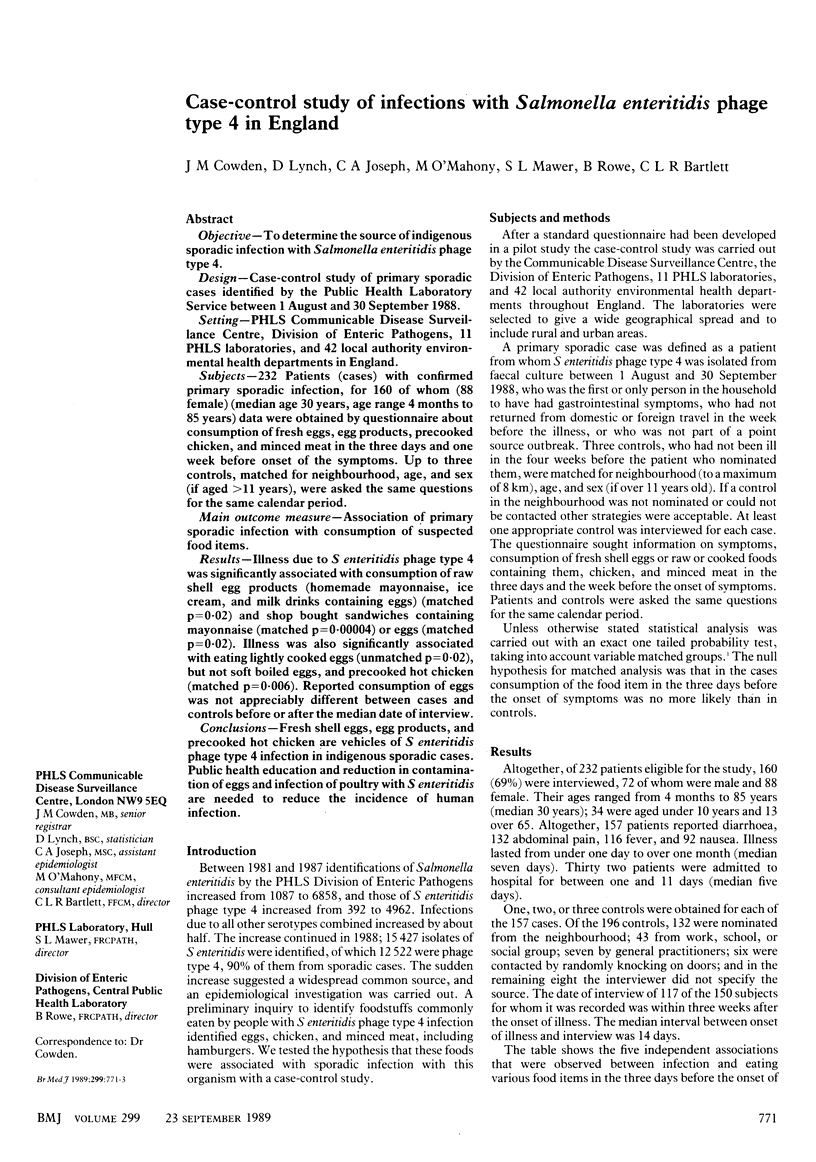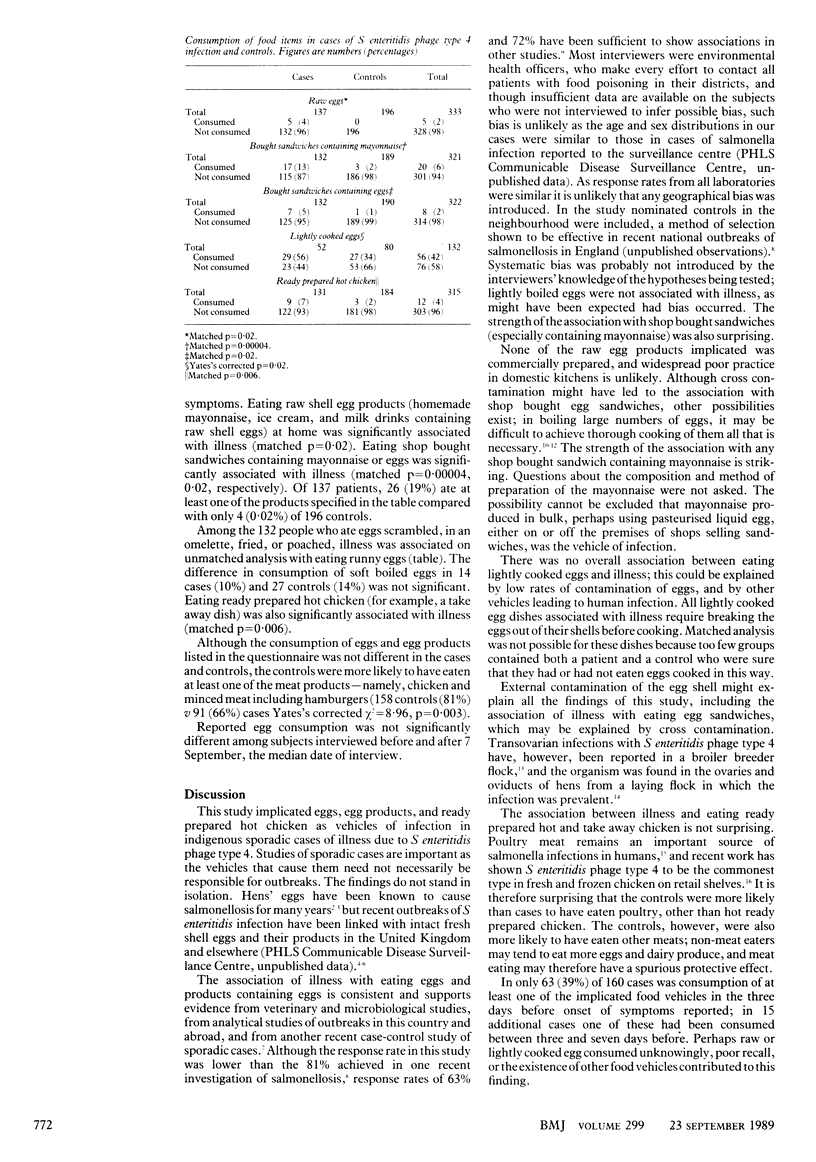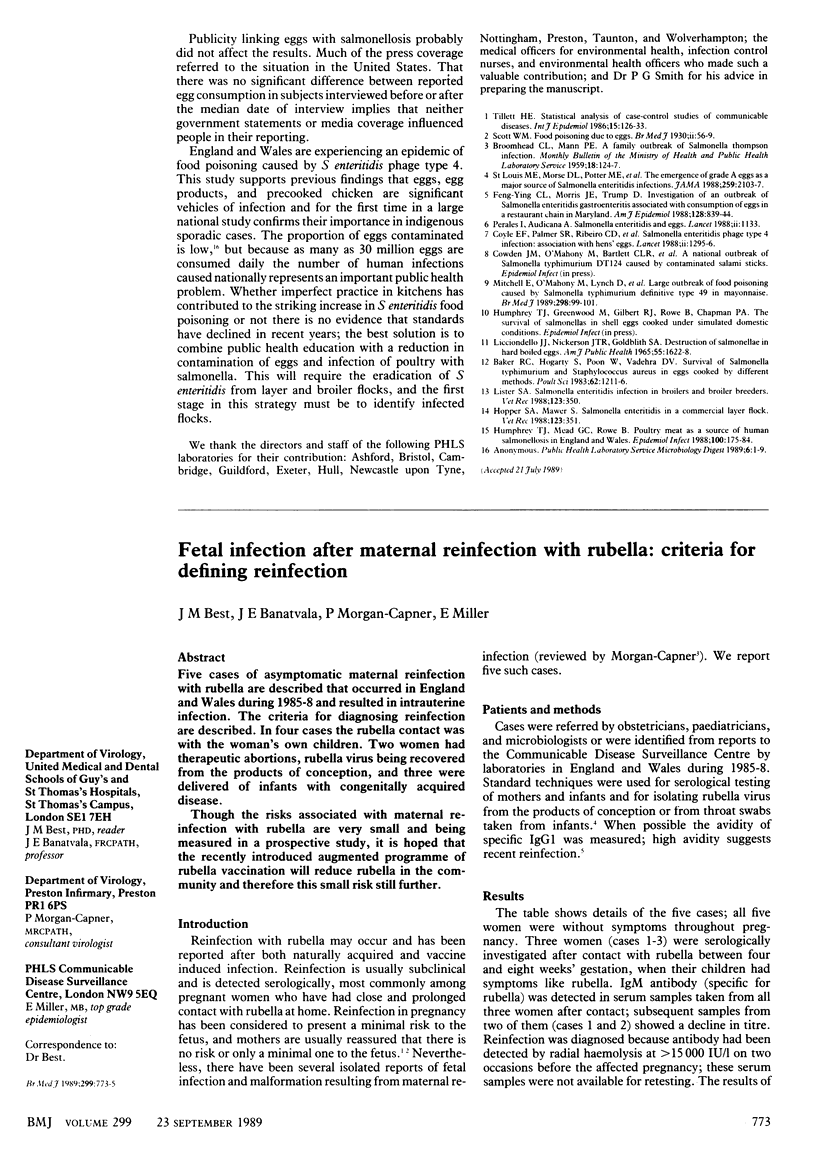Abstract
OBJECTIVE--To determine the source of indigenous sporadic infection with Salmonella enteritidis phage type 4. DESIGN--Case-control study of primary sporadic cases identified by the Public Health Laboratory Service between 1 August and 30 September 1988. SETTING--PHLS Communicable Disease Surveillance Centre, Division of Enteric Pathogens, 11 PHLS laboratories, and 42 local authority environmental health departments in England. SUBJECTS--232 Patients (cases) with confirmed primary sporadic infection, for 160 of whom (88 female) (median age 30 years, age range 4 months to 85 years) data were obtained by questionnaire about consumption of fresh eggs, egg products, precooked chicken, and minced meat in the three days and one week before onset of the symptoms. Up to three controls, matched for neighbourhood, age, and sex (if aged greater than 11 years), were asked the same questions for the same calendar period. MAIN OUTCOME MEASURE--Association of primary sporadic infection with consumption of suspected food items. RESULTS--Illness due to S enteritidis phage type 4 was significantly associated with consumption of raw shell egg products (homemade mayonnaise, ice cream, and milk drinks containing eggs) (matched p = 0.02) and shop bought sandwiches containing mayonnaise (matched p = 0.00004) or eggs (matched p = 0.02). Illness was also significantly associated with eating lightly cooked eggs (unmatched p = 0.02), but not soft boiled eggs, and precooked hot chicken (matched p = 0.006). Reported consumption of eggs was not appreciably different between cases and controls before or after the median date of interview. CONCLUSIONS--Fresh shell eggs, egg products, and precooked hot chicken are vehicles of S enteritidis phage type 4 infection in indigenous sporadic cases. Public health education and reduction in contamination of eggs and infection of poultry with S enteritidis are needed to reduce the incidence of human infection.
Full text
PDF


Selected References
These references are in PubMed. This may not be the complete list of references from this article.
- Baker R. C., Hogarty S., Poon W., Vadehra D. V. Survival of Salmonella typhimurium and Staphylococcus aureus in eggs cooked by different methods. Poult Sci. 1983 Jul;62(7):1211–1216. doi: 10.3382/ps.0621211. [DOI] [PubMed] [Google Scholar]
- Coyle E. F., Palmer S. R., Ribeiro C. D., Jones H. I., Howard A. J., Ward L., Rowe B. Salmonella enteritidis phage type 4 infection: association with hen's eggs. Lancet. 1988 Dec 3;2(8623):1295–1297. doi: 10.1016/s0140-6736(88)92902-9. [DOI] [PubMed] [Google Scholar]
- Hopper S. A., Mawer S. Salmonella enteritidis in a commercial layer flock. Vet Rec. 1988 Sep 24;123(13):351–351. doi: 10.1136/vr.123.13.351. [DOI] [PubMed] [Google Scholar]
- Humphrey T. J., Mead G. C., Rowe B. Poultry meat as a source of human salmonellosis in England and Wales. Epidemiological overview. Epidemiol Infect. 1988 Apr;100(2):175–184. doi: 10.1017/s0950268800067303. [DOI] [PMC free article] [PubMed] [Google Scholar]
- Lin F. Y., Morris J. G., Jr, Trump D., Tilghman D., Wood P. K., Jackman N., Israel E., Libonati J. P. Investigation of an outbreak of Salmonella enteritidis gastroenteritis associated with consumption of eggs in a restaurant chain in Maryland. Am J Epidemiol. 1988 Oct;128(4):839–844. doi: 10.1093/oxfordjournals.aje.a115037. [DOI] [PubMed] [Google Scholar]
- Lister S. A. Salmonella enteritidis infection in broilers and broiler breeders. Vet Rec. 1988 Sep 24;123(13):350–350. doi: 10.1136/vr.123.13.350. [DOI] [PubMed] [Google Scholar]
- Mitchell E., O'Mahony M., Lynch D., Ward L. R., Rowe B., Uttley A., Rogers T., Cunningham D. G., Watson R. Large outbreak of food poisoning caused by Salmonella typhimurium definitive type 49 in mayonnaise. BMJ. 1989 Jan 14;298(6666):99–101. doi: 10.1136/bmj.298.6666.99. [DOI] [PMC free article] [PubMed] [Google Scholar]
- Pak C. Y., Eun H. M., McArthur R. G., Yoon J. W. Association of cytomegalovirus infection with autoimmune type 1 diabetes. Lancet. 1988 Jul 2;2(8601):1–4. doi: 10.1016/s0140-6736(88)92941-8. [DOI] [PubMed] [Google Scholar]
- St Louis M. E., Morse D. L., Potter M. E., DeMelfi T. M., Guzewich J. J., Tauxe R. V., Blake P. A. The emergence of grade A eggs as a major source of Salmonella enteritidis infections. New implications for the control of salmonellosis. JAMA. 1988 Apr 8;259(14):2103–2107. [PubMed] [Google Scholar]
- Tillett H. E. Statistical analysis of case-control studies of communicable diseases. Int J Epidemiol. 1986 Mar;15(1):126–133. doi: 10.1093/ije/15.1.126. [DOI] [PubMed] [Google Scholar]


